Two Big Offenses; Will Anybody Be Able to Get Good Pitching? My ALCS Preview
Both offenses are really good. So who can pitch better becomes a big question. The Rangers have a deeper rotation but the Astros have better late inning relievers.
This has felt inevitable. The Rangers jumped out to an early lead in the AL West this season and the Astros spent all season tracking them down. On the last day of the season, the Astros won in Arizona while the Rangers lost to an eliminated Mariners, giving the two teams the same record 90-72. And with the tiebreaker going to the Astros, the won the AL West.
The playoffs have rendered that mostly moot. The Rangers picked themselves up after their bad weekend in Seattle and have won all five of their playoff games, sweeping both the Rays and the Orioles. The Astros dispatched the Twins in an efficient four games, now the battle for the Silver Boot is the American League Championship Series. And the Astros win of the Silver Boot in the regular season does not matter. This is the real battle for the Silver Boot.
This also feels like it will be an offensively forward series. The Rangers led the American League in runs scored this season thanks to a very deep lineup with not soft spots. But the Astros recovered from an early season hitting slump to be one of the best hitting teams in baseball over the last four months of the season. In fact, from August 2 to the end of the season, they hit as well as any team in baseball.
So if both teams can hit, the question moves from the plate to the mound—which team can pitch the best? The ability to get shutdown innings against these excellent offenses becomes crucial, because one can always be confident that their team is likely to score the next time they come to the plate. And thus shutting down the opposing bats becomes bigger.
As always, I will preview the series by looking at each team’s key offensive and defensive numbers (including fielding) across the season and discuss the lineups, rotations, and bullpens, ranking each by a broad metric of run creation (OPS+) or prevention (ERA+ for starters; FIP for relievers).
Such a method allows me to focus on the broader quality of the two teams. Then I discuss “what to watch for” in the series, which talks about the areas of the series where one team can exploit another’s weakness or where the strengths of the two teams will create a big inflection point in the series.
The Pitching
By reputation, the Astros have a better pitching staff, especially at the top end and at the back of the bullpen. But looking at the numbers does not show any advantage for the Astros on the mound. The Astros allowed 698 runs on the season and the Rangers only allowed 18 more. If you look toward the bottom of the table below, you can see that Astros hurlers and Rangers hurlers gave up very similar slash lines to opposing batters this season. The Astros allowed opponents an OPS of .724, which is 17th best in the majors. The Rangers allowed opponents an OPS of .719, which was one spot better.
But the two pitching staffs get there in different ways. The Astros pitchers strike out a lot more batters—1460 on the season as compared to 1351 for the Rangers. Strikeouts are of course good because one avoids the vagaries of batted ball luck and will definitely keep an opponent from advancing a baserunner.
Astros pitchers also walk a lot more batters than Rangers pitchers do. The Astros walked 537 batters this season, while the Rangers issued 491 free passes—46 fewer. Both pitching staffs give up a lot of home run balls. The Rangers gave up 198 round trippers, the Astros three more.
In short, both pitching staffs have important vulnerabilities. The Rangers do not strike enough batters out and the Astros walk too many. And both give up home runs at high rates.
The Rotation
On paper, the rotation is an advantage for the Rangers, especially now that it looks like Max Scherzer and Jon Gray will be back from their injuries and on the ALCS roster. The Rangers are deeper in the rotation with average to above average starting pitchers. The Astros have holes deeper in the rotation and are at a decided disadvantage on the bump in Games 3 and 4.
Both front offices identified the rotation as an area of concern at the trade deadline and added frontline starters. The Game 1 matchup will be between the two best starters traded at the deadline—Justin Verlander for the Astros and Jordan Montgomery of the the Rangers. Both have been quite good for their new teams.
The matchup looks even in the first two games and the decidedly in favor of the Rangers in Games 3 and 4 (and 7 if it gets to that). But there is a big but here. Both Game 2 starters (Valdez and Eovaldi) have been inconsistent down the stretch, though Eovaldi has been better so far in the playoffs than Valdez. And similarly, Javier and Urquidy have pitched well in their last two starts under playoff conditions. The Rangers don’t know what they are getting from Scherzer and Gray, both of whom just returned from the injured list. Can they rely on them to get them deep into a game or wihll they have to piggy-back them with some of their extra starting pitchers (e.g. Andrew Heaney, Dane Dunning).
The Bullpens
The biggest advantage for the Astros in this series is in the bullpen. On the season, Astros relievers had an ERA of 3.56, seventh best in the majors. The Rangers bullpen had an ERA of 4.77, 24th best. That advantage comes down when one looks at stats like FIP because Astros relievers tend to give up a lot of walks. But in general, the Astros trust their back end relievers. Outside of Jose LeClerc, who took over late in the season as their closer, the Rangers do not.
By FIP, Aroldis Chapman is the best reliever in this series, but almost all of his good FIP comes from his work earlier this season in Kansas City. The Astros have the actual best reliever in this series in Bryan Abreu, who again was dominant in the ALCS. The Astros lack a left handed reliever in their ‘pen, but the Rangers’ best hitters are right handed, so that is less of an issue than it was in the Twins series.
The Fielding
For several years as I’ve been writing these previews, I usually note that the Astros have a big advantage on defense and this advantage could be a key difference in the upcoming short series. That is true again, except this time, the advantage is with the Astros opponent.
The Rangers are one of the top handful of defensive teams in the majors and they are ahead of the Astros in each of the defensive categories shown int he chart. The easiest to understand is defensive efficiency, which is a simple measure of the percentage of balls hit into play turned into out. The Astros turn 69.7 of balls into outs. The Rangers turn 70.3% into outs.
The biggest individual defensive advantage for the Rangers is at second base. Marcus Semien, a converted shortstop, was credited with 16 Defensive Runs Saves (2nd best among MLB second baseman) and 13 Outs Above Average (5th best). Jose Altuve was credited with -13 Defensive Runs Saved, which was worst among MLB second baseman, though he was rated better in Outs Above Average, where his -1 number was 24th best in the Majors. But regardless of the measure, second base is a big defensive advantage for the Rangers.
The Hitting
Both teams can hit. It’s why each of them got to the playoffs. The Astros scored 5.10 runs per game throughout the regular season. They slumped in the first two months of the season at the plate and took off to become one of the top offenses in baseball. But the Rangers were one of the top offenses all season.
One can see the overall quality and consistency of the Rangers offensive numbers. They rank second or third in the majors is just about every offensive category. It is worth noting their power. They hit homers (3rd best, tied with the Twins) and they hit doubles (2nd best in the majors). Where they do not rank near the absolute top of the majors is in strike zone judgment. The Rangers strikeout a good bit (15th most in the majors) but walk a lot (5th best). They are willing to take pitches to get a pitch they can drive.
The Astros, in contrast, avoid the strikeout (3rd lowest rate in the majors) but that approach leads to fewer walks (15th best). They homer frequently, but not as often as the Rangers. Over most teams, the Astros usually have an advantage in batting average, but not in this matchup. The Rangers get hits at a slightly higher rate.
The Lineups
The Rangers have a good lineup because it is a deep lineup. They have eight hitters who had a league average or better OPS+ in the 2023 season, and the one guy who didn’t (center fielder Leody Tavares) was just three percent below league average. In short, there are no soft spots in the Rangers order and each batter can do damage at the plate.
The Astros offenses is less deep, and four of the Astros regulars had an OPS+ of below 100 this season. The good news for the Astros is that one of those players—Jose Abreu—has been hot since returning from the IL in late August. He homered three times in the division series, and he and Michael Brantley combined for all of the Astros RBIs in the Game 4 win.
The Astros offensive advantage is at the top. They have three star level hitters—Yordan Alvarez, Jose Altuve, and Kyle Tucker. The Rangers only have one in Corey Seager, though Evan Carter has been hot since being called up on September 8 and has continued to stay hot in the playoffs so far.
Keys to the Series
Can Astros pitchers limit the walks? Ranger hitters are fifth best in the majors in drawing walks and Astro hitters are eleventh worst at allowing walks. It is not a good matchup for the Astros as the Rangers do not chase—they have the 25th highest chase rate in the majors. The Rangers hit the ball well enough that extra baserunners are an even bigger problem than usual.
Can Astros hitters take advantage of making extra contact against Rangers pitchers? Ranger pitchers don’t strike a lot of batters out and Astros hitters don’t strike out a lot. That should mean that the Astros are able to put more balls in play and need to take advantage of that with extra singles and scoring runners from third base with less than two outs.
How well do Cristian Javier and Jose Urquidy pitch in their starts? The Astros won their series against the Twins in large part because Javier and Urquidy pitched much better than their regular season numbers. The high quality Rangers lineup has thumped lots of pitchers this season and will be favored to do that against Javier and Urquidy. It’s a bad matchup for the Astros that can be turned around by good pitching.
Can the Astros hitters get to the Rangers bullpen? The Rangers biggest weakness is in their bullpen, which ranked in the bottom third of MLB teams in most categories. It’s the part of the game where the advantage shifts most to the Astros hitters and they need to take advantage.
Who wins the middle innings? This is a corollary of the last two points. The biggest decision managers make in postseason baseball is how to handle the third time through the order, which usually comes up between the fourth through the sixth inning. Starters do worse against hitters here, but both managers have a tendency to ride their starters into this period of the game. Which teams gets the best work from its starters here or their middle bullpen arms?
Who Is the Favorite and Does It Matter?
The gamblers have the Astros as the favorites in the ALCS, as FanDuel lists the Astros with -148 odds and the Draft Kings lists them at -140. Humans have the Rangers as the favorite; eleven of the sixteen baseball writers who ventured a prediction at The Athletic predicted a Rangers win.
My review of the numbers indicates that the humans are right here. The Rangers hit better than the Astros over the course of the season thanks to their deeper lineup and that the Rangers have a deeper staff of staring pitchers. The Astros have a clear advantage in the bullpen though.
But the computer models disagree with analysis by me. Four different computer models list the Astros as the favorite in the series, and some by relatively high numbers for these models when examining a short series.
Most of these models see the Astros lineup as stronger than it was during the regular season. And there is some good reason to believe that. The Astros offense slumped over the first two months of the season but then broke out in a big way over the last four months of the season. Over the last two months of the regular season, the Astros outhit the Rangers—Astros: .277/.354/.478. wRC+ 130; Rangers: .247/.332/.448. wRC+ 111. And the Astros have more top level offensive stars than do the Rangers.
It feels like the series will be a slugfest as it features two top offenses who have big advantages over the pitching staffs. So the question becomes when will the pitchers be able to shut down each team’s potent offense.
It is thus hard to pick a favorite in this series and in many ways that does not matter. Short series baseball is not about what you did for 162 games or even for the series before this. It is about what you do right now. In that sense, anything can happen because it will be four to seven baseball games.
It is not hard to have faith in the Astros in October though. They keep coming through.




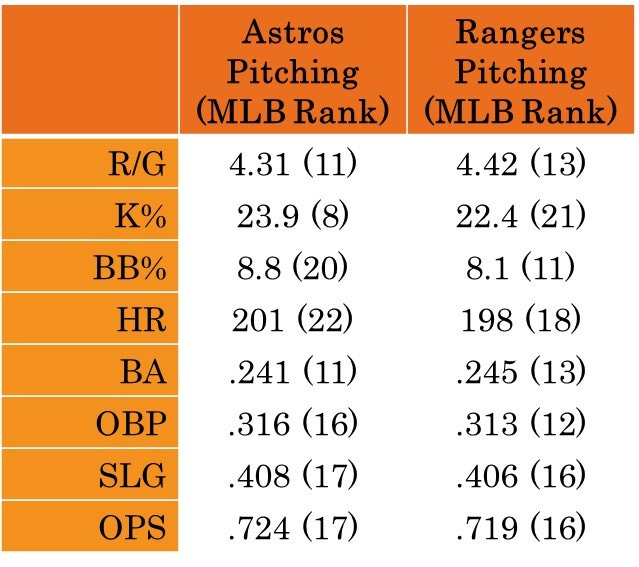

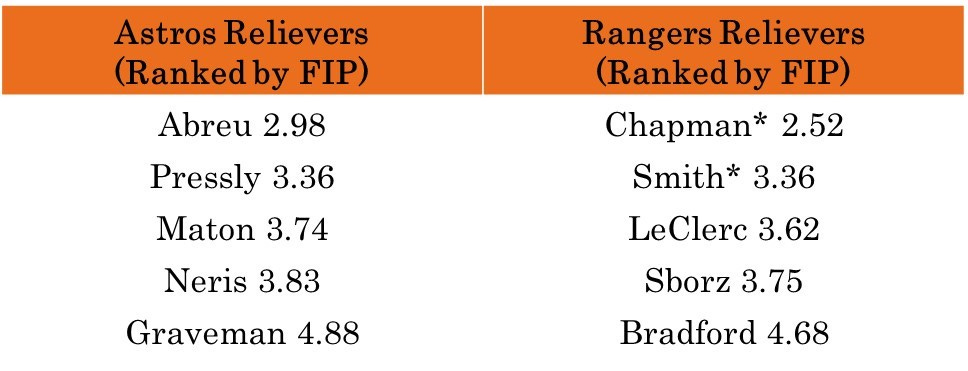
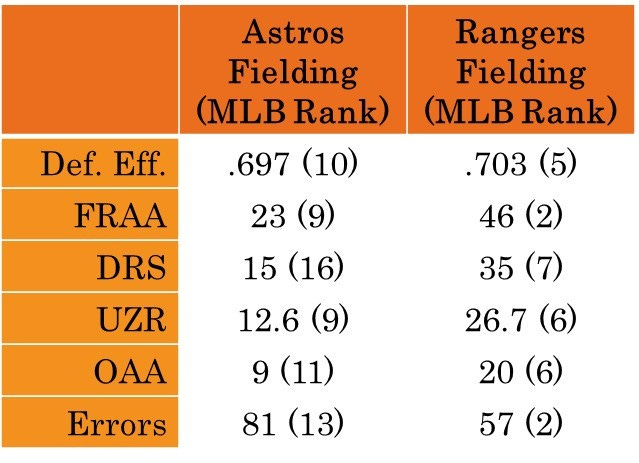
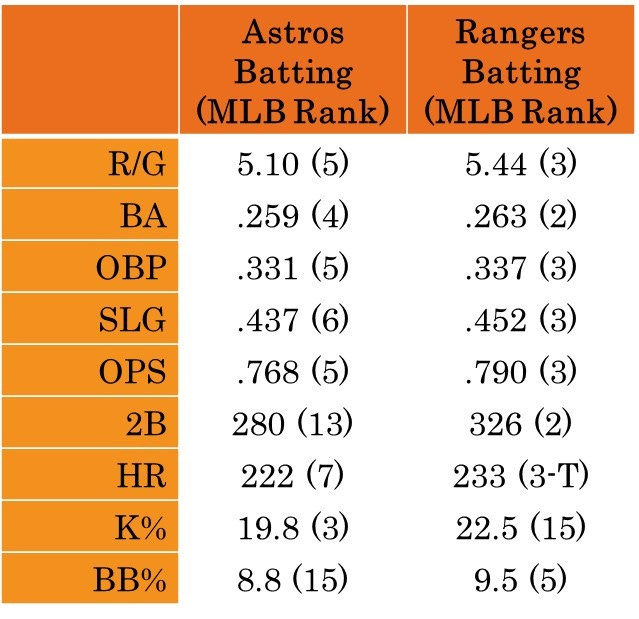
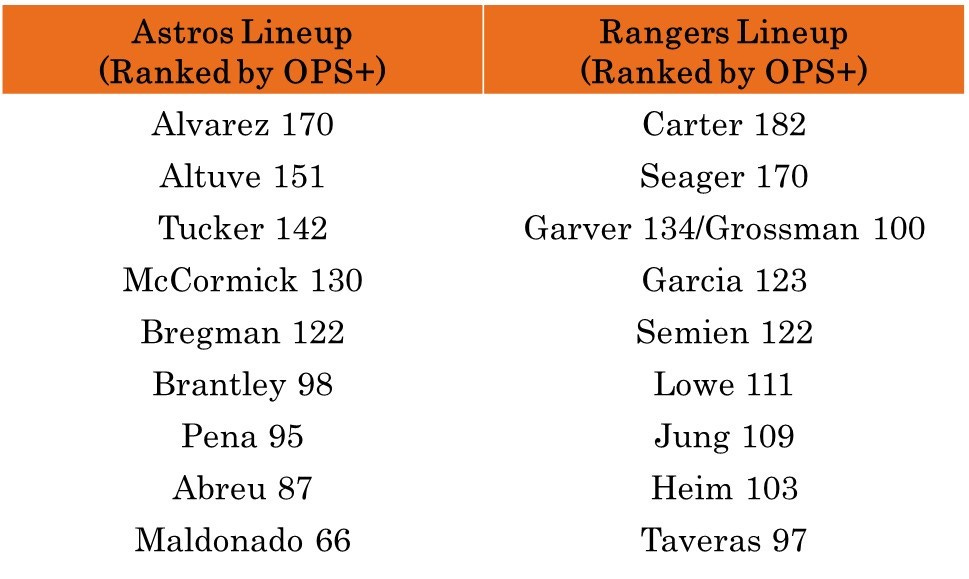
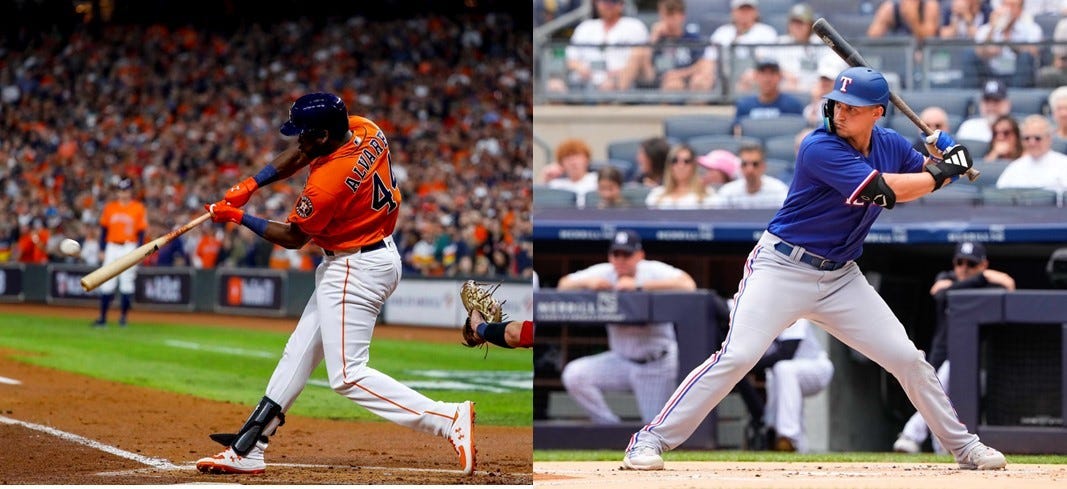

This series is going to be a beauty! As a neutral to the series, I firmly believe it's going to be incredibly entertaining going 6 or 7 games.
Great analysis Brian! Your use of the teams stats made sense to me🙂👍⚾️